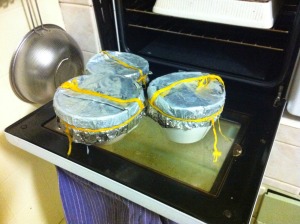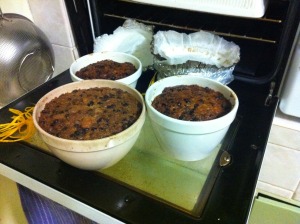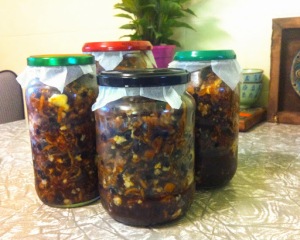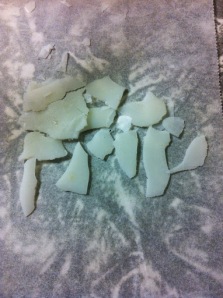It’s a bit unfortunate that I started this blog in the middle of a new project; Christmas pudding. I learnt a lot of stuff. Mostly about suet.
They took 6 hours to steam so forgive the horrid fluro lighting of my kitchen at 10pm! And yes, that’s yellow yarn (who knew my love of knitting would spew over into my food blog so early on?!). But here they are:
I did A LOT of reading before embarking on this project, mostly because I was a bit undecided about the use of suet. A few weeks ago I made some mincemeat which also traditionally uses suet, but since I was still firmly on the fence…I erred on the side of delicious, familiar, butter.
If you’re not familiar with it, suet is raw beef fat from around the kidney and loins…hence my initial trepidation about using it. There are a number of suggested alternatives to its use including butter and vegetable shortening but neither have quite the same properties as suet.
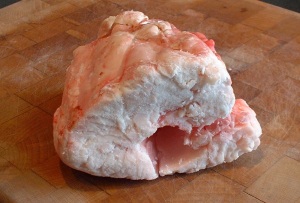
Yum… (Source: Wikipedia)
Back in suet’s glory days (if there was ever a time?) it was used for all sorts of things like puddings, dumplings, sausages, haggis(es?) as well as lamp oil, candles, soap and as a leather treatment. Nowadays it seems that suet goes to the birds.


What’s so special about suet that can’t be replicated by butter or other solid fats? Suet has a higher melting temp than most substitutes which means that it only begins to melt just as the surrounding batter is beginning to set. When it does melt, long into the cooking process, it leaves a void in its place which makes for a much lighter, spongier pudding. And no, it doesn’t leave a meaty flavour. In comparison, butter which has a lower melting temperature than suet, will melt before the pudding has a chance to set which will leave your pudding heavy and greasy.
Why suet and not regular beef fat? I only started to ask myself this after I looked at my first hunk of suet and wondered whether the butcher had ripped me off (granted…he did give it to me FOR FREE!) as my piece(s) looked nothing like the images I’d so faithfully googled!
Frantically, I googled again and came across Savoring the Past and its article aptly titled (for my particular situation anyway!) Suet, Part two: What it is, What it isn’t, and What to Look For. Is it a bit sad to admit that my heart actually skipped a little joyfully when I found this? It is, but I’m OK with that.
To save you from reading the whole article…basically suet is different to regular fat at the molecular level (oooh, science!). This accounts for its milder taste, higher melting temp and the way it completely hardens after you render it. This is the critical difference between suet and regular muscle fat.

Rendered beef fat (Source: Savoring the Past)

Rendered suet (Source: Savoring the Past)
With this in mind I chopped a couple of small pieces off the suspect suet and cooked it over low heat in a fry pan for about 10 minutes. Ideally I should have done it in the oven at its lowest setting but honestly, I couldn’t be bothered! And it worked out just fine. I poured the melted fat onto a bit of baking paper (saves on washing!) and watched on with trepidation as it cooled. Would it be like granny’s mashed potatoes? Or granny’s lavender soap?!
Huzzah! The butcher gave me suet!
Was it all worth it? I guess we’ll have to wait till Christmas to find out!
